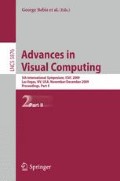Abstract
The zebrafish embryo is a common model organism for cardiac development and genetics. However, the current method of analyzing the embryo heart images is still mainly the manual and visual inspection through the microscope by scoring embryos visually - a very laborious and expensive task for the biologist. We propose to automatically segment the embryo cardiac chambers from fluorescent microscopic video sequences, allowing morphological and functional quantitative features of cardiac activity to be extracted. Several methods are presented and compared within a large range of images, varying in quality, acquisition parameters, and embryos position. Despite such variability in the images, the best method reaches a 70% of accuracy, allowing reducing biologists workload by automating some of the tedious manual segmentation tasks.
Access this chapter
Tax calculation will be finalised at checkout
Purchases are for personal use only
Preview
Unable to display preview. Download preview PDF.
References
Vermot, J., Fraser, S., Liebling, M.: Fast fluorescence microscopy for imaging the dynamics of embryonic development. HFSP Journal 2, 143–155 (2008)
Luengo-Oroz, M.A., Faure, E., Lombardot, B., Sance, R., Bourgine, P., Peyriéras, N., Santos, A.: Twister segment morphological filtering. A new method for live zebrafish embryos confocal images processing. In: ICIP, pp. 253–256. IEEE, Los Alamitos (2007)
Fink, M., Callol-Massot, C., Chu, A., Ruiz-Lozano, P., Belmonte, J.C., Giles, W., Bodmer, R., Ocorr, K.: A new method for detection and quantification of heartbeat parameters in drosophila, zebrafish, and embryonic mouse hearts. BioTechniques 46(2), 101–113 (2009)
Liebling, M., Forouhar, A., Wolleschensky, R., Zimmermann, B., Ankerhold, R., Fraser, S., Gharib, M., Dickinson, M.E.: Rapid three-dimensional imaging and analysis of the beating embryonic heart reveals functional changes during development. Developmental Dynamics 235, 2940–2948 (2006)
Hu, N., Sedmera, D., Yost, H., Clark, E.: Structure and function of the developing zebrafish heart. The Anatomical Record 260, 148–157 (2000)
Zuiderveld, K.: Contrast Limited Adaptive Histogram Equalization. In: Graphics Gems IV, pp. 474–485. Academic Press, London (1994)
Otsu, N.: A threshold selection method from gray-level histograms. IEEE Trans. on Systems, Man and Cybernetics 1, 62–69 (1979)
Bishop, C.M.: Pattern Recognition and Machine Learning (Information Science and Statistics). Springer, Heidelberg (2007)
Imelinska, C., Downes, M., Yuan, W.: Semi-automated color segmentation of anatomical tissue. Computerized Medical Imaging and Graphics 24, 173–180 (2002)
Li, C., Xu, C., Gui, C., Fox, M.: Level set evolution without re-initialization: A new variational formulation. In: CVPR, vol. 1, pp. 430–436. IEEE, Los Alamitos (2005)
Li, C.: Home page, http://www.engr.uconn.edu/~cmli/
Vincent, L., Soille, P.: Watersheds in digital spaces: an efficient algorithm based on immersion simulations. IEEE Transactions on Pattern Analysis and Machine Intelligence 13, 583–598 (1991)
LaViola Jr., J.: Double exponential smoothing: An alternative to kalman filter-based predictive tracking. In: Immersive Projection Technology and Virtual Environments, pp. 199–206 (2003)
Zhang, H., Fritts, J.E., Goldman, S.A.: Image segmentation evaluation: A survey of unsupervised methods. Computer Vision and Image Understanding 110, 260–280 (2008)
Sezgin, M., Sankur, B.: Survey over image thresholding techniques and quantitative performance evaluation. Journal of Electronic Imaging 13, 146–168 (2004)
Cox, T., Cox, M.: Multidimensional Scaling, 2nd edn. Chapman & Hall/CRC, Boca Raton (2001)
Ge, F., Wang, S., Liu, T.: New benchmark for image segmentation evaluation. Journal of Electronic Imaging 16, 33011 (2007)
Author information
Authors and Affiliations
Editor information
Editors and Affiliations
Rights and permissions
Copyright information
© 2009 Springer-Verlag Berlin Heidelberg
About this paper
Cite this paper
Krämer, P. et al. (2009). Comparison of Segmentation Algorithms for the Zebrafish Heart in Fluorescent Microscopy Images. In: Bebis, G., et al. Advances in Visual Computing. ISVC 2009. Lecture Notes in Computer Science, vol 5876. Springer, Berlin, Heidelberg. https://doi.org/10.1007/978-3-642-10520-3_100
Download citation
DOI: https://doi.org/10.1007/978-3-642-10520-3_100
Publisher Name: Springer, Berlin, Heidelberg
Print ISBN: 978-3-642-10519-7
Online ISBN: 978-3-642-10520-3
eBook Packages: Computer ScienceComputer Science (R0)

